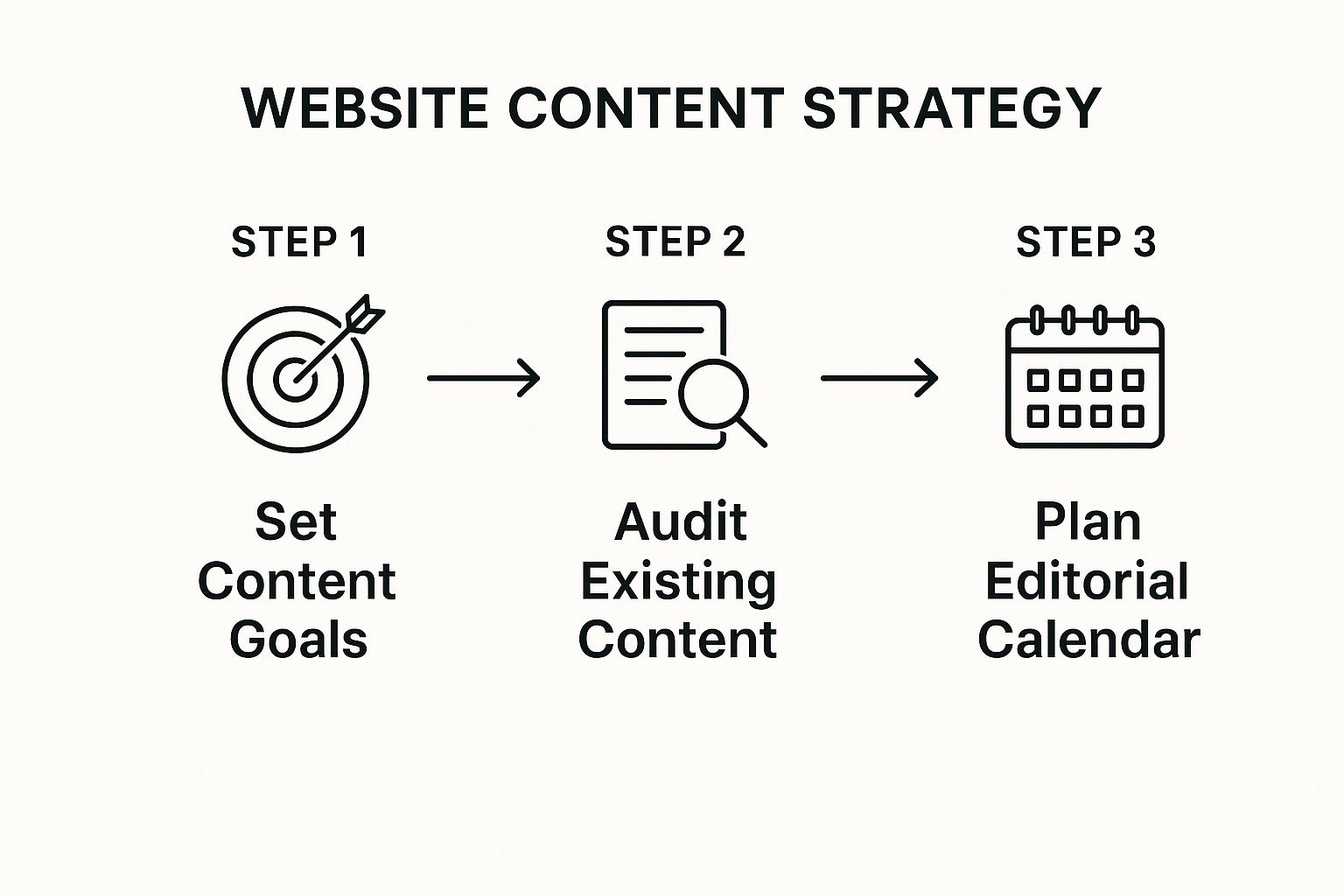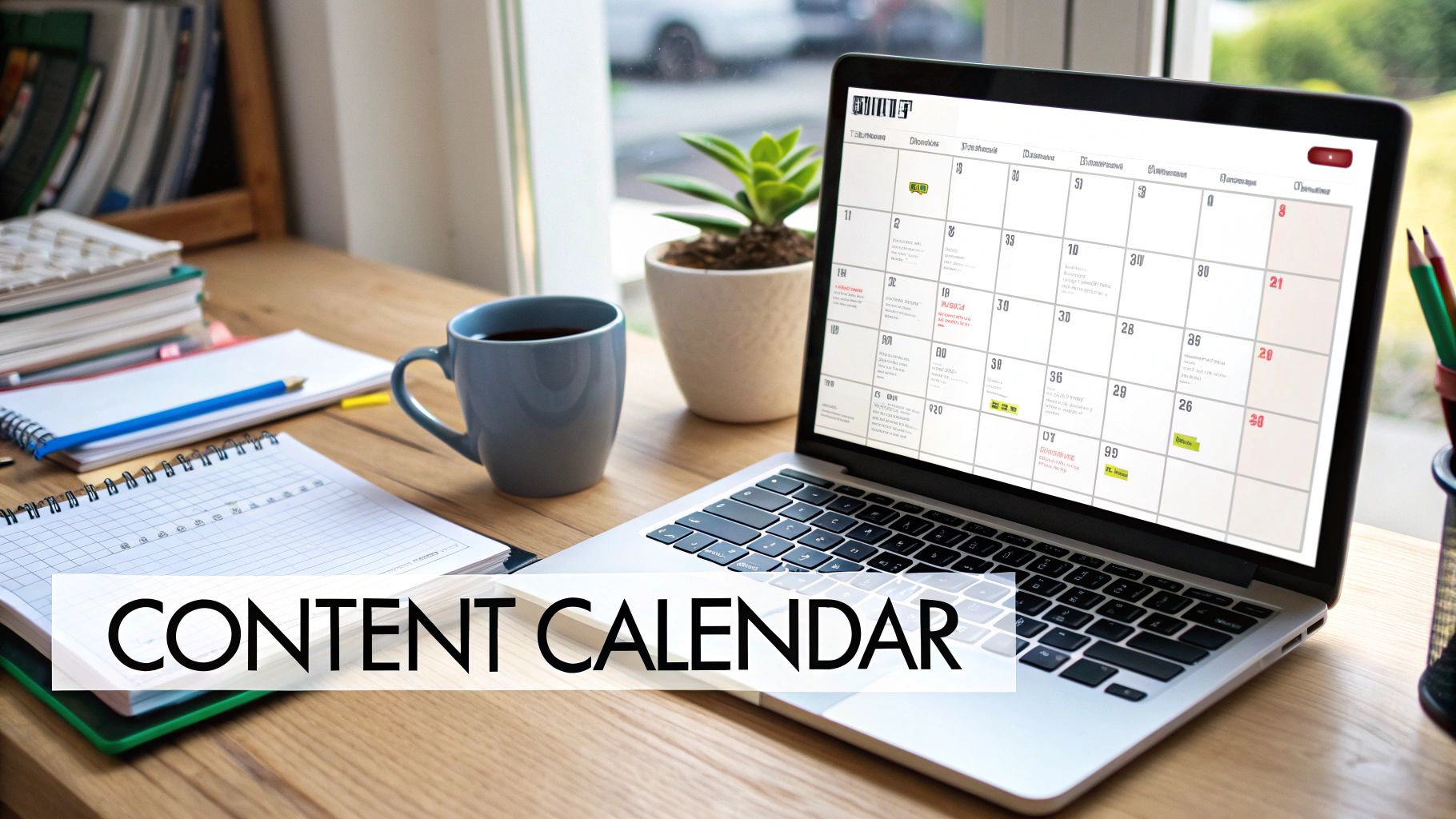A successful website content strategy is more than just a plan; it's the very blueprint for everything you publish online. It's about making sure every blog post, every guide, and every video has a clear purpose. You move away from random acts of content and start a coordinated effort that builds real authority and, ultimately, grows your business.
Building Your Strategic Foundation
Before you even think about writing, you need to lay the groundwork. A powerful content strategy isn't built on assumptions. It's built on deliberate, informed decisions that connect your content directly to what your business needs to achieve. This initial planning is what separates content that genuinely works from content that just exists.
This stage is all about getting to know your audience on a deeper level. Forget basic demographics for a moment. What are their biggest headaches? What keeps them up at night? What questions are they frantically typing into Google? When you can answer these, you can create content that doesn't just attract them but truly helps them.
Set Clear and Measurable Goals
Your strategy needs a destination. "Get more traffic" is a wish, not a goal. You need to be specific and set measurable objectives. A great way to do this is with the SMART framework (Specific, Measurable, Achievable, Relevant, Time-bound).
Think in terms of concrete outcomes:
- Boost organic traffic by 20% over the next six months.
- Generate 50 qualified leads each month from our blog.
- Cut down customer support queries by 15% by creating better help articles.
- Increase user engagement, like time on page, by 25%.
These kinds of targets give you focus and make it far easier to track your return on investment. This clarity is especially vital when you design a website for a small business, where every bit of effort needs to deliver results.
Audit Your Existing Content
Chances are, you're not starting from scratch. A content audit is simply a review of everything you've already published. You’re looking for what’s working, what isn't, and what's missing entirely. You'll often find hidden gems that just need a quick update or old posts that can be repurposed into something new. To really get this right, it helps to follow a robust content strategy framework that keeps the entire process organised.
The infographic below shows how these initial steps flow into a proper publishing plan.

This structured approach is becoming the norm for a reason. In the UK, a solid 72% of companies now have a documented content marketing strategy. They're also getting creative with formats; 50% use images and short-form video, while 37% lean on infographics to capture attention and explain complex ideas.
To put it all together, a strong content strategy rests on a few essential pillars. Each one has a distinct job to do, but they all work together to support your overall business goals.
Core Content Strategy Components
| Component | Objective |
|---|---|
| Audience Research | To deeply understand the needs, pain points, and questions of your ideal customer. |
| Clear Goals (SMART) | To define what success looks like in specific, measurable terms. |
| Content Audit | To evaluate existing content to find opportunities for improvement and identify gaps. |
| Keyword Strategy | To target the exact phrases your audience uses to find solutions online. |
| Editorial Calendar | To plan and organise content creation and publication for consistency. |
Building out each of these components gives you a clear path forward, turning your content from a cost centre into a reliable engine for growth.
Creating Content That Actually Connects

With a solid strategic foundation in place, it’s time to roll up our sleeves and get to the heart of it: creating the content itself. This is where all that research into your audience and your goals pays off, turning plans into tangible pieces that people genuinely want to read, watch, and share. A powerful website content strategy hinges on picking the right format for your message and delivering it with a voice that’s consistently and authentically yours.
It’s not just about what you say anymore; how you say it is what truly makes the difference. Whether that’s a deep-dive blog post that cements your expertise or a punchy video that puts your brand's personality on display, each format has a unique role to play in building that connection.
Matching Content Formats to Your Goals
Let's be clear: not all content formats are created equal. The medium you choose can make or break your message, so your decision needs to be a deliberate one, guided by what you want to achieve and what your audience actually enjoys.
Think about it this way. If your goal is to build topical authority and start ranking for some of those high-value, competitive keywords, then long-form blog posts and in-depth guides are your best bet. They offer the substance required for both your audience and search engines to see you as a credible, go-to resource.
But what if you want to build a real community and show the human side of your brand? That’s where video shines. It’s no surprise that video is taking over UK content strategies. In fact, by 2025, an incredible 83% of UK consumers want to see more video from brands, and 50% of businesses are already using short-form video to get people talking. This excellent report on content marketing statistics dives even deeper into these trends.
A brilliant piece of content in the wrong format is like a perfectly crafted key for the wrong lock. It simply won't open the door to your audience. The key is to align the message, the medium, and the audience's consumption habits.
Developing an Authentic Brand Voice
Your brand voice is the personality that comes through in everything you publish. It’s the difference between sounding like a faceless corporation and sounding like you. When you get this right, you build trust and a sense of familiarity with your audience.
To pin down your voice, try thinking of your brand as a person. What are they like?
- Are they professional and authoritative, like a trusted advisor you’d turn to for serious matters?
- Maybe they’re friendly and witty, like that clever friend who always has a smart take?
- Or perhaps they're inspirational and encouraging, like a coach who motivates you to succeed?
Once you’ve got a clear picture, document it. It doesn’t need to be a fifty-page document; a simple style guide will do. Outline your tone, a few key phrases to use (and any to avoid), and your stance on things like humour or industry jargon. This simple step ensures that anyone creating content for you, from in-house staff to freelancers, stays on the same page.
For a real-world example, imagine a local IT support company. Instead of using dry, impenetrable language, they could decide to sound like a helpful, patient "tech-savvy friend." That small but crucial shift makes their advice far more approachable and less intimidating for their target audience of small business owners. Suddenly, their website content strategy isn't just about information—it's about building loyalty and a genuine connection.
Right, you've got your strategy sorted. But even the best ideas can fizzle out if you don't have a solid plan to bring them to life. This is precisely where an editorial or content calendar saves the day. It’s the operational blueprint that turns your grand website content strategy into a daily, weekly, and monthly reality. It's what keeps your team humming along, organised, and consistently publishing great stuff.
Think of it as the crucial link between your ambitious goals and the actual blog posts, videos, and social updates that will get you there. A well-managed calendar eliminates that last-minute panic for topics and guarantees a reliable stream of content your audience can count on.
Finding and Picking Your Topics
First things first, you need to fill your calendar with potential ideas. This isn’t about just throwing stuff at the wall to see what sticks. We're talking about focused topic generation, drawing directly from your audience research and SEO goals. You're looking for that sweet spot where your audience's biggest headaches meet your business's best solutions.
I find it's best to use a mix of techniques to build a really robust topic list:
- Keyword Deep Dives: Use your preferred SEO tool to discover the actual questions your audience is typing into Google. Look for those wonderfully specific long-tail keywords, like "best IT support for Norfolk businesses," which signal strong intent.
- A Peek at the Competition: What are your rivals writing about? Don't just copy them. See if you can explore the topic in more depth, offer a fresh perspective, or provide information that's more current and relevant.
- The Goldmine of Customer Questions: Your sales and support teams are on the front line. What questions do they field over and over again? Turning those common queries into detailed blog posts can be a massive time-saver for them and incredibly valuable for your audience.
Once you have a healthy list of possibilities, it's time to get ruthless and prioritise. Let's be honest, not every content idea carries the same weight. You need to weigh the potential impact against the effort involved. That high-impact, low-effort article answering a burning customer question? That should probably jump to the front of the queue, ahead of that complex research report that will take weeks to complete.
How to Structure Your Content Calendar
Your calendar can be as simple as a spreadsheet or as sophisticated as a project management tool like Trello or Asana. Honestly, the tool you choose matters less than the information you put into it. The goal is to have a clear system that organises your content pipeline and leaves no doubt about who is doing what and when.
A content calendar isn't just a schedule; it's a commitment. It holds your team accountable for producing consistent, high-quality content that moves the needle. It transforms a vague 'we should post more' into a concrete 'here's exactly what we're publishing next Tuesday'.
At a bare minimum, every single entry in your calendar should track the essentials. Think of it like a flight plan for each piece of content.
- Publish Date: When is this piece going live?
- Topic/Headline: The working title.
- Content Format: Is it a blog post, a video, a case study?
- Target Keyword: What's the main SEO phrase we're aiming for?
- Author: Who's on the hook for creating it?
- Status: A simple progress tracker (e.g., Idea, In Progress, In Review, Scheduled) lets you see the status of everything in a single glance.
By mapping all this out, you build a reliable system. It's a system that not only ensures you're publishing consistently but also makes certain that every single article or video is pulling its weight and contributing to the wider goals of your website content strategy. This organised, methodical approach is the engine that will power your long-term growth.
Amplifying Your Content For Maximum Reach

Hitting ‘publish’ is a fantastic moment, but in reality, it’s just the starting gun. A brilliant piece of content that nobody ever sees won't help your business one bit. The real power of a website content strategy kicks in after you publish, when you proactively get your work in front of the right people. This is how you turn a simple article into an asset that genuinely drives results.
This process, often called content amplification, is a mix of smart on-page SEO and getting out there to spread the word. It's about making sure your content shows up in search results while also taking it directly to the online spaces where your audience hangs out.
Mastering On-Page SEO Essentials
First things first, you need to give search engines like Google every chance to understand and rank your content. This isn't about clumsily stuffing keywords everywhere. It’s about sending clear, structured signals that your page is high-quality and relevant.
A great place to start is your meta description. Think of this little snippet as your advert on the search results page. Your job is to make it compelling enough to earn that click, so be sure to include your main keyword. Just as crucial is your internal linking. Whenever you publish a new article, find older, relevant posts on your site and link from them to your new piece. This simple step helps search engines find your new content faster and shares some authority from your more established pages. For retail businesses, this is a core tactic, along with other ways to boost your business with top ecommerce trends.
Don’t just publish and pray. A proactive amplification plan ensures your content investment pays dividends by reaching a wider, more engaged audience. It’s the difference between shouting into the void and starting a meaningful conversation.
Taking Your Content to the Community
While SEO is the long game, you can get eyes on your content straight away by promoting it across different channels. This is where you actively start conversations.
Your email list is an incredibly powerful tool for this. These are people who have already opted in and are interested in what you have to say. Send out a broadcast to your subscribers about your new post, giving them a clear reason why it’s worth their time to read.
Social media is another non-negotiable channel. With social media now reaching 79% of the UK population, you simply have to be there. At the same time, influencer marketing is becoming a huge deal, with UK ad spend expected to reach £1.04 billion in 2025. Working with the right micro-influencers can bring a level of authenticity and reach that’s hard to get on your own. You can dive deeper into these trends in this UK social media statistics report.
Consider adding these promotional tactics to your routine:
- Share on Social Media: Don't just post once. Create different posts for each platform. You could share a professional takeaway on LinkedIn, ask an engaging question on Facebook, and create a visual summary for Instagram.
- Engage in Niche Communities: Places like Reddit are full of dedicated communities (subreddits) on almost any topic imaginable. To really amplify your content, you can share it in relevant subreddits where it provides genuine value. Using a Reddit Post Generator can help you create posts that fit the platform's style and drive traffic back to your site.
- Repurpose Your Content: Don’t let your hard work sit in one format. A detailed blog post can be transformed into a series of short video clips for TikTok, a professional slide deck for LinkedIn, or a shareable infographic. This gives you more to share and appeals to people who prefer different types of media.
When you combine solid SEO with smart promotion, you create a powerful cycle. The initial traffic and social signals from your promotional push can help boost your search rankings, leading to more organic traffic long after you've stopped actively promoting the piece.
Measuring What Matters to Refine Your Strategy

A truly effective website content strategy is never really "done". Think of it as a living plan that needs to breathe and adapt based on how it performs in the real world. This is the point where you move past guesswork and start making decisions backed by hard data, turning raw analytics into genuine, actionable insights.
This feedback loop is your secret weapon. It shows you what’s hitting the mark so you can double down on it, and what’s falling flat so you can learn from it. Without this process, you’re essentially flying blind and likely wasting precious time and resources on content that just doesn't connect.
Focus on the Right KPIs
It’s incredibly easy to drown in the ocean of data available to you. The key is to zero in on the Key Performance Indicators (KPIs) that actually reflect the goals you set at the very beginning. Forget obsessing over vanity metrics like total page views; you need to dig deeper into the numbers that reveal genuine engagement and have a real impact on your business.
I find it helpful to group KPIs by what they actually tell me:
- Audience Growth & Reach: Keep a close eye on unique visitors and organic search traffic. Is your audience growing month-on-month? Are you seeing steady improvement in your search rankings for those all-important keywords?
- Engagement: Metrics like average time on page and bounce rate are your window into how compelling your content really is. If people are only spending a few seconds on a long article, it's a sign it isn't holding their attention. A high bounce rate might mean the content simply didn't live up to the promise of its headline or search result.
- Conversion: This is where your content truly proves its value. Track tangible results like newsletter sign-ups, form submissions for quotes, or resource downloads. For an e-commerce business, the ultimate metric is, of course, sales generated directly from a piece of content.
Your analytics tell a story. Learning to read that story is how you transform a simple blog post into a reliable business asset. The data shows you what your audience truly values, not just what you think they value.
Turning Insights Into Action
Tools like Google Analytics are fantastic, but the data is meaningless without interpretation. You have to put time on your calendar—weekly or monthly—to sit down, review performance, and ask the tough questions.
Let’s say you see a blog post about "IT support for Suffolk businesses" has an unusually high time on page and is bringing in a few leads through its contact form. That’s a massive clue. It's telling you loud and clear that creating more hyper-localised content that speaks to specific regional pain points is a winning formula.
On the flip side, what if a series of articles gets plenty of traffic but generates zero conversions? It's time to play detective. Is the call-to-action buried or unclear? Is the content asking for a big commitment too early in their journey?
This constant cycle of measuring, analysing, and adjusting is what separates a decent website content strategy from a truly great one. It’s a process that ensures your efforts become more efficient and more effective over time.
A Few Common Content Strategy Questions Answered
Even with the best-laid plans, you're going to have questions as you start putting your website content strategy into action. It happens to everyone. Let's walk through some of the most common stumbling blocks I see businesses run into, so you can keep moving forward with confidence.
How Often Should I Be Publishing New Content?
This is the big one, isn't it? But honestly, there’s no magic number. The real secret? Consistency always trumps frequency.
It’s far, far better to publish one truly brilliant, well-researched article every single week than to pump out five average posts whenever you find the time. Start with a schedule you know your team can stick to without burning out. That might be weekly, fortnightly, or even monthly. The important thing is to create a rhythm your audience can learn to expect.
Once you’ve found your groove, you can start looking at the data. Does posting more often actually move the needle on your traffic and leads? Let the results, not a random number, dictate your publishing cadence.
Think of it this way: Your content strategy is the ‘why’—it’s the big-picture vision that defines who you’re talking to and what you want to achieve. The content calendar is the ‘how’ and the ‘when’—it's the nuts-and-bolts tool that puts your strategy into practice day by day.
Understanding this difference is vital. Your strategy is what gives your calendar meaning, making sure every blog post or video has a clear purpose.
How Long Will It Take to See Results?
I'll be straight with you: content marketing is a long game. If a big part of your strategy hinges on search engine optimisation (SEO), you need to be prepared to wait 6 to 12 months to see substantial, meaningful growth in your organic traffic. This isn't a quick fix; it requires patience and a commitment to consistently doing the work.
That said, you don’t have to wait a year to know if you're on the right track. You can absolutely spot early signs of life within the first few months. Keep an eye out for these positive signals:
- A noticeable uptick in your social media engagement.
- More people signing up for your email newsletter.
- An increase in enquiries through your contact form.
- Positive comments and direct feedback from your readers.
These early wins are proof that your message is starting to resonate, even before those big search engine rankings kick in. Tracking them is great for keeping your team's morale high, too.
Should I Delete Old or Underperforming Content?
My immediate answer is almost always no. Don't be so quick to hit the delete button. A better approach is to think in terms of "refresh and consolidate".
Often, an article that isn't performing well can be given a new lease of life. Updating it with fresh statistics, optimising it for better keywords, and adding some new visuals is much quicker than writing a whole new piece from scratch. To avoid these issues in the future, it's worth reading up on the common mistakes in SEO and how to avoid them.
Another fantastic tactic is to take several shorter, weaker posts on a related subject and merge them into one powerhouse resource. The only time I’d ever really recommend deleting content is if it’s factually wrong, completely irrelevant to your business today, and brings in absolutely no search traffic.
Ready to build a website and content strategy that drives real growth for your business in Norfolk or Suffolk? The team at Ibertech Solutions Limited specialises in creating bespoke web and marketing solutions that get results. Contact us today for a free consultation.





